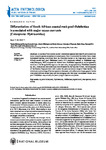Differentiation of South African coastal rock pool Ochthebius is associated with major ocean currents (Coleoptera: Hydraenidae)
| dc.contributor.author | Bilton, David | |
| dc.date.accessioned | 2021-07-08T16:06:26Z | |
| dc.date.available | 2021-07-08T16:06:26Z | |
| dc.date.issued | 2021-07-05 | |
| dc.identifier.issn | 1804-6487 | |
| dc.identifier.issn | 0374-1036 | |
| dc.identifier.uri | http://hdl.handle.net/10026.1/17311 | |
| dc.description | No embargo required. | |
| dc.description.abstract |
A number of non-marine coastal invertebrate species have been found to constitute (semi-) cryptic species complexes in recent years. Here it is revealed that rather than a single widespread species, distributed from the Namibian border to the Cape south coast, South African coastal rock pool Ochthebius Leach, 1815 previously referred to Ochthebius capicola (Péringuey, 1892) comprise two distinct taxa. Ochthebius capicola (s. str.) is apparently restricted to the Benguela Ecoregion on the west coast, being replaced by Ochthebius mlamboi sp. nov., in south and east coast localities influenced by the Agulhas Current, including areas of the Eastern Cape province well outside the previous known range of these beetles. The distribution and ecology of the two species is discussed, with reference to biogeographic breaks in southern African coastal taxa, and the emerging view that many ‘widespread’ coastal rock pool Ochthebius may actually be (semi-) cryptic species complexes. | |
| dc.format.extent | 253-260 | |
| dc.language.iso | en | |
| dc.publisher | National Museum, Czech Republic | |
| dc.subject | Aquatic Coleoptera | |
| dc.subject | Hydraenidae | |
| dc.subject | Ochthebius | |
| dc.subject | supralittoral | |
| dc.subject | new species | |
| dc.subject | South Africa | |
| dc.title | Differentiation of South African coastal rock pool Ochthebius is associated with major ocean currents (Coleoptera: Hydraenidae) | |
| dc.type | journal-article | |
| dc.type | Journal Article | |
| plymouth.author-url | https://www.webofscience.com/api/gateway?GWVersion=2&SrcApp=PARTNER_APP&SrcAuth=LinksAMR&KeyUT=WOS:000719157400001&DestLinkType=FullRecord&DestApp=ALL_WOS&UsrCustomerID=11bb513d99f797142bcfeffcc58ea008 | |
| plymouth.issue | 1 | |
| plymouth.volume | 61 | |
| plymouth.publisher-url | https://www.aemnp.eu/ | |
| plymouth.publication-status | Published online | |
| plymouth.journal | Acta Entomologica Musei Nationalis Pragae | |
| dc.identifier.doi | 10.37520/aemnp.2021.015 | |
| plymouth.organisational-group | /Plymouth | |
| plymouth.organisational-group | /Plymouth/Faculty of Science and Engineering | |
| plymouth.organisational-group | /Plymouth/REF 2021 Researchers by UoA | |
| plymouth.organisational-group | /Plymouth/REF 2021 Researchers by UoA/UoA07 Earth Systems and Environmental Sciences | |
| plymouth.organisational-group | /Plymouth/Research Groups | |
| plymouth.organisational-group | /Plymouth/Research Groups/Marine Institute | |
| plymouth.organisational-group | /Plymouth/Users by role | |
| plymouth.organisational-group | /Plymouth/Users by role/Academics | |
| dcterms.dateAccepted | 2021-06-26 | |
| dc.rights.embargodate | 2021-7-5 | |
| dc.identifier.eissn | 0374-1036 | |
| dc.rights.embargoperiod | Not known | |
| rioxxterms.versionofrecord | 10.37520/aemnp.2021.015 | |
| rioxxterms.licenseref.uri | http://www.rioxx.net/licenses/all-rights-reserved | |
| rioxxterms.licenseref.startdate | 2021-07-05 | |
| rioxxterms.type | Journal Article/Review |


